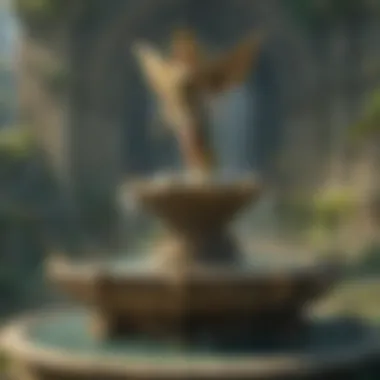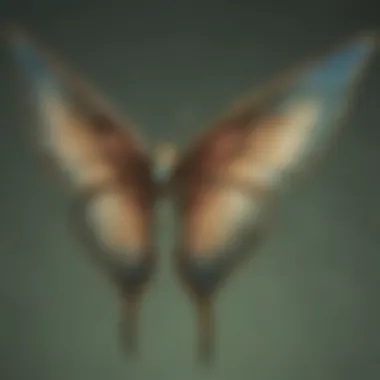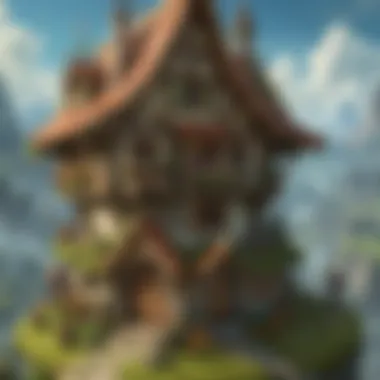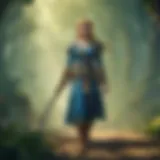Exploring Fairy Art in the Zelda Universe


Intro
In the vibrant world of the Zelda franchise, fairy art serves as a mesmerizing facet that binds the visual storytelling to the gameplay experience. It’s like the hidden spice in a dish that elevates its overall flavor. From the delicate flutter of wings to the ethereal glow enveloping these mystical beings, fairy art cultivates an ambiance that resonates deeply with fans.
Over the years, the portrayal of fairies has evolved significantly, revealing layers of meaning and inviting speculation among enthusiasts. This article embarks on a journey through the intricate realm of fairy art in the Zelda universe, shedding light on its artistic styles, contextual histories, and thematic significance.
As we peel back the layers of fairy representations, it becomes apparent that they do more than add a whimsical touch; they weave essential threads into the fabric of storytelling and emotional engagement while enhancing gameplay experiences. Throughout various games in the series, the fairies often act as harbingers of wisdom, guides for Link, and embodiments of the world’s spiritual essence.
So, let’s gear up for an exploration of fairy art, where fantasy and artistry entwine, revealing not just the visual charm but also the heart of what makes the Zelda series so enduring and impactful.
Intro to Fairy Art
Fairy art within the Zelda universe carries more significance than mere decoration; it serves as a bridge connecting the player with the deeply woven tale of heroism, adventure, and magic that this iconic franchise has been known for since its inception. Understanding fairy art isn't just about recognizing charming visuals, but also about grasping how these creations contribute to the overall narrative and emotional depth of the gaming experience. The unique portrayal of fairies enhances various game mechanics, while also reflecting a rich tapestry of cultural symbolism and artistic interpretation.
Defining Fairy Art
Fairy art in the Zelda context can be characterized as the artistic representation of mythical beings that embody magic, guidance, and mystery. Typically depicted with delicate features, vibrant colors, and whimsical elements, these portrayals are not only visually appealing but also laden with meaning. Fairies often serve as messengers of hope, akin to guiding stars in the night sky, inviting players to engage more deeply with the game's lore.
One might say that fairy art marries form and function. A fairy’s design isn’t arbitrary; it communicates purpose and sentiment. These creations range from the ethereal, delicate beings encountered in Ocarina of Time, to the more vivid and animated versions found in Breath of the Wild. Through design, movement, and interaction, fairy art narrates a story beyond words, inviting players to decipher layers of meaning woven into their interactions.
Historical Overview of Fairies in Mythology
The origins of fairies in mythology reveal a complex history of folklore, spanning across cultures and centuries. In many European tales, fairies were seen as nature spirits with the ability to assist or hinder humans. They were often viewed through a dual lens of enchantment and trepidation, as beings capable of immense beauty and immense chaos.
In the Zelda franchise, this duality is reflected. For example, in The Legend of Zelda: Ocarina of Time, the fairy Navi serves as both a helpful guide and a reminder of the perils that lie ahead. This concept stems from countless myths, where the fairy could offer gifts, but also play tricks.
- Influences on Fairy Portrayals:
- Celtic Lore: Fairies as mystical creatures connected to nature.
- Victorian Era: Transformation of fairies into more innocent, delicate figures.
- Modern Interpretations: Use of technology and art to bring the fairy essence into gameplay.
Drawing parallels between historical accounts and their representation in modern media enriches the understanding of fairy art's relevance. The careful weaving of these influences into modern Zelda titles showcases not just creative innovation but also respect for a long-standing tradition of storytelling that continues to captivate audiences.
"The fairy is a symbol—a creature straddling the line between wonder and fear, guiding you to new heights while shadows lurk in the corners." - Inspired by themes in mythology.
The Role of Fairies in the Zelda Franchise
When it comes to exploring the Zelda universe, one cannot overlook the critical role that fairies play in the storytelling tapestry. These ethereal beings are not merely whimsical decorations; they are woven deeply into the fabric of gameplay, progression, and player experience. Fairies serve as more than just characters; they embody essential thematic elements that resonate throughout the franchise. Each game introduces unique representations of fairies, which enrich the gameplay, deepen character engagement, and enhance the overall narrative.
Fairies resonate with players on multiple levels. From mobilizing players' nostalgia for past adventures to offering in-game assistance that feels both magical and rewarding, their presence has become a hallmark of the series. The way fairies interact with Link and assist him in his journeys underscores a variety of gameplay mechanics while adding an enchanting depth to the narrative experience. Their roles vary, yet they consistently serve pivotal purposes, making them significant cornerstones in the Zelda lore.
Key Appearances in Various Games


Throughout the extensive timeline of Zelda games, fairies have appeared in notable ways that enrich player's experiences. Let's delve into their key appearances:
- Ocarina of Time: Navi, perhaps one of the most recognized fairies, acts as a guidance system for players, helping Link navigate through the complexities of Hyrule, delivering crucial hints, and even acting as a health indicator. Her "Hey! Listen!" became a catchphrase, symbolizing the bridge between players and the game world.
- Majora's Mask: The game introduces the Great Fairies, whose transformations and enhancements bring Link's abilities to new heights. They serve as reflections of the game's themes of time and consequence.
- The Legend of Zelda: The Wind Waker: The fairies here embody whimsical designs and a playful role. Their integration into the storyline and gameplay illustrates how gameplay mechanics can pivot dramatically while still keeping true to the essence of fairy lore.
These appearances not only spotlight the diverse functionalities of fairies but also highlight how they evolve with each installment, adapting to the gameplay and storyline needs.
Fairies as Guardians and Guides
In the Zelda franchise, fairies are often portrayed as guardian figures. They protect sacred places and guide the hero, Link, toward significant quests. This duality reflects broader themes in mythology, such as guardianship and the passage between realms. For instance, in Ocarina of Time, fairies guard the temples and shrines, imparting wisdom and abilities necessary for Link to progress through the game.
These guides possess a near-goddess-like quality, often appearing during moments of crises or transition. Such symbolism casts fairies in a light that suggests they exist to assist and uplift, a recurring motif that resonates with the player.
A significant aspect of their role comes from their ability to personalize the journey. When players interact with fairies, it often leads to moments of reflection or growth, both for the characters and the players alike. This relationship forms a narrative thread that further entwines the players into the shared journey of Link's heroic endeavors.
"Fairies bridge the harmony between the hero's quest and the mystical forces of the Zelda universe. Their guidance often offers clarity in chaotic moments, making their presence indispensable in defining the essence of the journey."
In sum, the role of fairies in the Zelda franchise transcends simple gameplay mechanics. They illustrate a harmonious blend of storytelling, character development, and symbolic representation, each aspect enhancing the Zelda experience for players. Their influence underscores the idea that every guiding light has a purpose and meaning that resonates far beyond mere pixelated interactions.
Artistic Styles of Fairy Portrayals
When diving into the subject of Artistic Styles of Fairy Portrayals within the beloved Zelda franchise, it becomes clear that the visual representation of fairies serves as a mirror reflecting the thematic elements and emotional undertones of the games. The various artistic styles are not just aesthetic choices; they shape how players experience and relate to the fairy characters. A closer examination highlights how these styles encompass a variety of techniques, from vibrant color palettes to delicate line work, each contributing to the emotional weight of the scenes they inhabit.
The fairy art styles are critical as they reveal the nuances of each game’s atmosphere and narrative tone. For instance, some games favor a more whimsical approach, utilizing brighter colors and exaggerated features, while others lean towards a subdued palette, evoking feelings of nostalgia and, at times, melancholy. This diversity in visual presentation allows players to engage with the narratives differently depending on their own emotional states and perspectives. Also, these varying styles create a rich tapestry of visual storytelling that complements gameplay mechanics, encouraging players to explore deeper meanings behind each fairy’s role.
Visual Aesthetics Across Different Zelda Games
The visual aesthetics of fairies differ significantly across the Zelda games, providing each iteration with a distinctive flavor that resonates with players on multiple levels. In The Legend of Zelda: Ocarina of Time, for instance, fairies are ethereal, characterized by luminous hues and gentle movements that create a sense of peace and guidance. Their portrayal is almost reminiscent of magical fireflies, softening the harshness of Hyrule's trials and tribulations.
Conversely, in The Legend of Zelda: Breath of the Wild, fairies take on a more organic presence. They appear intertwined with their surroundings, as if seamlessly blending into the lush environments of Hyrule. This stylistic choice emphasizes the connection between fairies and nature, reinforcing their roles as guardians of the land. This approach resonates particularly well with players who appreciate environments that reflect an intricate relationship with flora and fauna.
Comparative Analysis of Fairy Design
Wind Waker Style
The Wind Waker shines with a cell-shaded aesthetic that sets the tone for its fairies. They bubble with life and vigor, composed of simple yet expressive designs that fit perfectly in the game’s overall lighthearted atmosphere. The key characteristic of this style is how the fairies appear almost cartoon-like yet retain a depth that draws players in. Their vibrant colors and playful designs resonate well with the theme of adventure, making them easily recognizable and beloved characters.
What makes Wind Waker’s fairy design stand out is the exaggerated features and fluid animations, injecting a sense of joy whenever they appear on screen. This uncomplicated yet effective approach enhances the gameplay by ensuring players feel connected to these beloved figures, allowing them to become an integral part of the narrative journey.
Ocarina of Time Approach
In contrast, Ocarina of Time features fairies that are delicately designed with a slightly more realistic touch — they possess softer edges and a more nuanced palette. This design choice underscores the fairy’s role as a guide through darker elements of the game. Their slightly ethereal glow provides comfort in the face of challenges. The key characteristic here lies in the intricate details, providing layers that hint at the rich lore behind their existence.


The unique feature of Ocarina of Time’s fairy design lies in how they evoke a sense of nostalgia. Players who journeyed through Hyrule with Navi or the Great Fairies often remember these encounters fondly. While some periodic gameplay interruptions could be seen as a disadvantage, the depth they add to character development in the narrative ultimately renders those moments worthwhile.
Breath of the Wild Innovations
With Breath of the Wild, fairies are portrayed with a stunning visual innovation that blends both artistry and interaction. Their designs are inspired by natural elements, with colors carefully chosen to reflect the environment around them. The key characteristic of this approach is a more fluid connection to the world, as fairies are not merely figures; they are part of Hyrule’s landscape—an extension of it, so to speak.
This unique feature allows players to engage with fairies in ways that are dynamic — they evolve from mere allies to vital components of the gameplay experience. The balance between distinct artistic elements and the emotionally charged designs helps to foster a gripping experience, offering players a sense of discovery that is rewarding both visually and narratively. In this sense, the innovations of Breath of the Wild set the stage for future explorations of fairy art within the franchise’s evolving landscape.
Symbolism and Thematic Elements
The intersection of fairy art and thematic expressions in the Zelda universe is a vast tapestry, weaving together visual splendor with deeper meanings. Fairies are not merely decorative elements; they serve as profound symbols with the capacity to evoke emotions and convey messages pertinent to the game's narrative and player experience. This section delves into two prominent themes: the connection between fairies and nature, and their embodiment of hope and healing.
Fairies and Nature
Fairies, often depicted as ethereal, delicate beings, are frequently associated with the natural world. Their design draws inspiration from various elements of nature, enhancing the game's immersive quality. For example, in The Legend of Zelda: Ocarina of Time, the fairies' vivid colors and organic shapes mirror the lush landscapes of Hyrule, bridging the gap between the mystical and the ecological.
The aesthetic choices in illustrating fairies help players connect to the environments they traverse. The soft, glowing appearance of fairies not only captivates but also signifies vitality and growth, grounding their existence in the ecosystems of the games. This corresponds with the recurring theme of nature's resilience, drawing a parallel to how players, much like these fairies, strive to restore balance in the face of adversity.
By immersing players in these interactions, fairies symbolize harmony and the relationship between humans, the world, and the unseen forces that govern them.
Representation of Hope and Healing
In the lore of the Zelda series, fairies often embody hope and serve as catalysts for healing, both physically and spiritually. Their presence in gameplay provides players with not just aid but reassurance. For instance, in The Legend of Zelda: Breath of the Wild, fairies have the ability to enhance armor and assist in survival, which deepens their significance as sources of strength.
Fairies are portrayed as benevolent entities, offering blessings that are akin to a warm embrace on a cold night. Their design and role evoke the idea that even in dark times, there are glimmers of help waiting to be found. The simple act of encountering a fairy can stir an appreciation for the sense of community and support layered throughout the Zelda experiences.
"The fairy's gentle light reminds players that hope endures even in the face of challenges."
These thematic elements wrap around the core concepts of growth, recovery, and optimism, resonating not just within gameplay but also with players' emotional journeys. The design and representation of fairies create a narrative space where healing and hope are ever-present, reinforcing the overall philosophy of the Zelda franchise.
Engaging with these symbols offers fans a deeper understanding and appreciation of not only the artistry involved but also the underlying messages that accompany the enchanting fairy art across the series.
Fairies in Gameplay Mechanics
The concept of fairies in the Zelda series transcends mere aesthetic appeal; they play a pivotal role in shaping gameplay mechanics. Fairies have been instrumental in enhancing the gameplay experience, ensuring players engage with the environment and the narrative in multifaceted ways. By providing boosts, guidance, and unique interactions, these enchanting beings enrich the journey of Link and contribute to the overall depth of the games.
Functionality in Game Progression
Fairies serve a variety of functions in the context of game progression, which can greatly influence how players approach challenges. For instance, in Ocarina of Time, the Great Fairy upgrades equipment and bestows new abilities upon Link, often changing the dynamics of combat or exploration. Such enhancements aren't just a means to an end; they invite players to explore every nook and cranny of Hyrule, looking for these pivotal encounters. By integrating these characters into the progression system, players feel encouraged to invest time in exploration and side quests, deeply affecting their experience.
One notable example of functionality is from Breath of the Wild, where the Great Fairies play a crucial role in upgrading armor. This not only affects Link's defense but also alters gameplay strategies against numerous enemies throughout Hyrule. Players must often gather specific materials, which promotes interaction with the vast environments and systems. Each appearance of a fairy marks a moment of potential growth for the player, emphasizing the importance of their existence in the game.


Impact on Player Strategy
Engaging with fairies also impacts player strategy significantly. Their abilities often compel players to rethink their approaches. For example, if a player is struggling with a specific boss, they may choose to seek out a fairy to upgrade their weapons or abilities, shifting their focus and providing a different lens through which to view challenge resolution. This adds layers to the gameplay, making it not just about direct combat, but also about strategic planning and resource management.
Furthermore, references to fairies often evoke nostalgia or curiosity among players. Fans actively discuss techniques for finding them and often share tips on forums like reddit.com for optimal gameplay. Such community engagement revolves around these magical characters, reinforcing their role not just as in-game elements but as cultural icons among the Zelda fanbase. Players analyze the best times to seek these encounters and the most efficient routes, ultimately enhancing both their skill set and appreciation for the game.
Fan Interpretations and Community Engagement
The colorful tapestry of the Zelda universe is further enriched by the vibrant voices of its fans, who often find deeper meanings and new interpretations of fairy art. This community engagement not only amplifies the impact of the game but also fosters a rich dialogue around its themes and artistic choices. Fairies, as whimsical as they seem, spark serious discussions on emotional undertones and narrative layers that developers may have considered.
This engagement is essential for several reasons. First, fans act as cultural interpreters, breaching the gap between the original artistic intent and the audience's perception. Through their lens, the fairy art transforms from a simple design choice to an intricate symbol reflecting broader themes like hope, nature, and healing. Second, these interpretations lead to a greater appreciation of detail, pushing individuals to explore the iconic artwork with a discerning eye.
Lastly, the conversation surrounding fairy art really shapes how a community collectively remembers and redefines their relationship with the franchise.
Artistic Contributions by Fans
When it comes to fan artistry, the creative output from the Zelda community is nothing short of astounding. Talented enthusiasts examine fairy portrayals and reimagine them in their unique styles across various media, from illustrations and digital paintings to sculptures and cosplays. Platforms like DeviantArt and ArtStation serve as vibrant galleries where the grassroots creativity of the community thrives, showcasing pieces that range from whimsical prints to profoundly detailed interpretations.
Popular characters, such as the Great Fairy or Navi, see countless renditions that demonstrate diverse capabilities. Each piece represents a personal interpretation, utilizing various styles like realism, minimalist line art, or even anime-inspired forms. This not only allows for exploration within the existing world of Zelda but also engenders a sense of belonging among creators and fans who feel a pull towards these mystical figures.
Moreover, artists sometimes collaborate, inspiring each other and intertwining their narratives. Group challenges and themed contests stimulate innovation, yielding stunning artwork that reflects the essence of fairy art while injecting fresh narratives and perspectives.
Lore Expansion through Creative Mediums
The limitless confines of fan art extend into storytelling as well. Many fans use their creativity to expand existing lore or even create original narratives focusing on fairies and their role in the Zelda universe. Fan fiction often serves as an expansive playground, where writers elaborate on the emotions that fairies evoke, establishing backstories that been hinted at but not fully explored in the games. This often propels deeper engagement by providing context that sparks new debates and discussions.
Social media platforms, such as Reddit and Facebook groups, facilitate this expansive discourse. Fans share theories and creations, engaging in constructive dialogues that bridge the strawman arguments surrounding lore intricacies. By utilizing threads and posts, they explore myriad theories regarding the origins of fairies or their connections to major events in the Zelda timeline.
In recent times, collaboration with digital tools has made it easier to create multimedia projects. Videos created on platforms like YouTube combine animation with voiceovers to breathe life into original narratives inspired by fairy art.
“The magic of fairies in Zelda goes beyond how they look; it’s about the stories we weave and share.”
This boundless exploration of character and lore further emphasizes how community engagement with fairy art enhances the joy of being part of the Zelda franchise, helping to solidify its legacy and draw in new fans who wish to delve deeper into its rich narrative world.
Epilogue
Fairy art serves as more than mere aesthetic embellishment within the Zelda universe; it encapsulates a rich dialogue between gameplay, storytelling, and the emotional landscape of players. This article has traversed the complex layers of fairy representation, illuminating its historical roots, artistic evolution, and symbolic potency. Each fairy character, from the helpful sprites of Ocarina of Time to the ethereal beings in Breath of the Wild, carries the weight of narrative significance that enhances the player's journey.
Recap of Fairy Art's Significance
The significance of fairy art is multifaceted. First, it reflects cultural and mythological influences, drawing from the deep well of fairy lore that stretches across various civilizations. In Zelda games, fairies often symbolize hope, guidance, and the connection to nature. They are distinct characters that not only enrich the game world but also provide tangible benefits to players. For example, Navi in Ocarina of Time doesn't just serve a functional role but has grown into an iconic presence, giving her an emotional essence that resonates with players long after the game ends.
Furthermore, the artistic portrayal of fairies has evolved, showcasing different styles that align with the game's overall aesthetic. This transformation—whether in art style, character design, or narrative exposition—marks the progression and maturity of the franchise. The recurring depiction of fairies underlines their importance as facilitators of the player’s growth and experience in the game.
Future Directions for Exploration
Looking ahead, the exploration of fairy art in the Zelda universe could take several intriguing paths. There is value in delving deeper into how fan interpretations affect perceptions of these characters, shaping community engagement and even influencing new characters in upcoming games. The conversations and fan creations surrounding fairies can provide a fresh perspective on established lore. Additionally, future titles could expand on cultural narratives associated with the fae, allowing for new storytelling techniques and gameplay mechanics that incorporate fairy symbolism more prominently.
Moreover, a comprehensive examination of the impact of emerging technology, such as augmented reality, on fairy integration into the gaming experience can enhance player interaction and emotional investment. The interplay between traditional design and modern tech promises limitless possibilities for the representation and role of fairies.







